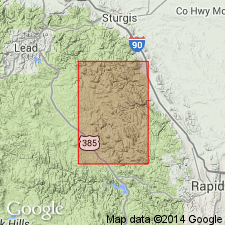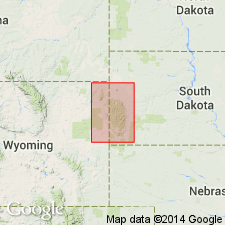
- Usage in publication:
-
- Benchmark Iron-formation*
- Modifications:
-
- Named
- Dominant lithology:
-
- Iron-formation
- AAPG geologic province:
-
- Midcontinent region
Summary:
Named as the upper formation of the Nemo Group (revised) for exposures northeast of the village of Benchmark, W1/2 sec 7, T3N, R5E, Lawrence Co, SD in the Midcontinent region. These exposures are the type locality. Occurs in many separate scattered outcrops in the central part of the mapped area in Lawrence and Meade Cos. Unconformably? overlies the middle Precambrian Boxelder Creek Quartzite (new), basal formation of the Nemo Group. Unconformably underlies the middle Precambrian Estes Conglomerate (revised). Consists of banded quartz-specularite-magnetite iron-formation (about 30 percent Fe). Of middle Precambrian age.
Source: GNU records (USGS DDS-6; Denver GNULEX).

- Usage in publication:
-
- Benchmark Iron-formation*
- Modifications:
-
- Age modified
- AAPG geologic province:
-
- Midcontinent region
Summary:
Mapped with other iron-formations unit Xif (Pl. 1) of Early Proterozoic age in the Midcontinent region of SD. Is unconformably overlain by the Early Proterozoic Estes Formation. Geologic map.
Source: GNU records (USGS DDS-6; Denver GNULEX).
For more information, please contact Nancy Stamm, Geologic Names Committee Secretary.
Asterisk (*) indicates published by U.S. Geological Survey authors.
"No current usage" (†) implies that a name has been abandoned or has fallen into disuse. Former usage and, if known, replacement name given in parentheses ( ).
Slash (/) indicates name conflicts with nomenclatural guidelines (CSN, 1933; ACSN, 1961, 1970; NACSN, 1983, 2005, 2021). May be explained within brackets ([ ]).

